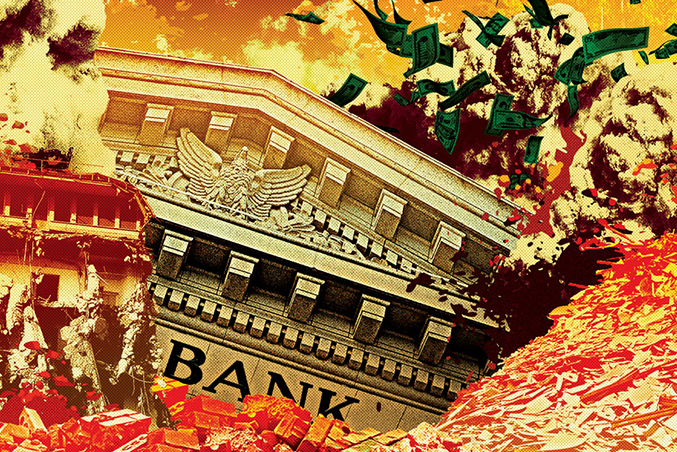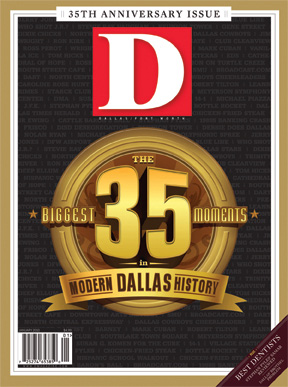In 1986, Dallas was considered a banking powerhouse. Oil was flowing, money was being spent, and all was well. Then the world came crashing down. Oil prices plummeted and the Tax Reform Act of 1986 left banks with massive loans. By 1992, 506 commercial banks had been closed. Businesses moved out of their downtown offices, creating a wasteland. Today, the city is still recovering.
As the sun rose on January 1, 1986, Dallas possessed the 17th, 20th, and 25th largest banking companies in the United States: First RepublicBank Corporation, MCorp, and InterFirst Corporation. They were also the three largest banking companies in Texas, with combined assets of $63.4 billion.
Four short years later, as the sun set on the decade, Dallas didn’t have a single home-based bank with more than $1 billion in assets. Dallas had been transformed from one of the nation’s great banking powers to a financial wasteland. The financial landscape had permanently changed, and with it Dallas lost the engine of growth that built one of America’s greatest cities.
The story of their demise is a tortured Greek tragedy that should never have happened and that can’t be completely told or understood unless you lived at the heart of the story.
The decade of the 1980s began during an oil boom that started with the Arab oil embargo of 1973 and pushed the Texas real estate and energy economies to giddy heights. Money poured into the state, resulting in prosperity and a spending binge that was unparalleled in Texas—and perhaps in U.S. history.
Unfortunately, boom was followed by bust, creating an economic tidal wave that swept over the state, catching Dallas in its vortex. The beginning of the end occurred in the first quarter of 1986, when the price of oil plummeted from $35 per barrel to $9.75 per barrel in three calamitous months. This was quickly followed by the passage of the Tax Reform Act of 1986, which removed most of the tax incentives for individuals and businesses to own real estate, leaving the Texas and Dallas banks, which were laden with real estate loans, vulnerable to the following devaluation of real estate.
Against this background, Congress had deregulated the nation’s savings and loan industry, creating an atmosphere in which every crooked fox in Dallas found a fertile and lucrative henhouse to plunder. A small band of thieves built and ravaged Empire Savings, Vernon Savings, Sunbelt Savings, and Western Savings. These organizations grew in aggregate from a few hundred million to more than $5 billion in assets in less than four years as a result of loose and illegal lending practices, “hot shop” deposit soliciting call centers, and self dealing.
One of the most ludicrous and unsound loans was made by Sunbelt Savings, aka “Gunbelt Savings,” to a real estate investor in Dallas to buy 84 Rolls Royce automobiles for $3 million from the Bhagwan Shree Rajneesh of the commune Rancho Rajneesh, Oregon. Thirty-six of these cars were hand-painted by the Bhagwan’s staff with peacocks and geese in flight. Not surprisingly, the loan went sour. All of the above mentioned S&Ls were closed by federal regulators, and their CEOs were all convicted of fraud and sentenced to lengthy prison sentences.
Unfortunately, the S&L crisis, the abuses at Penn Square Bank in Oklahoma City, and its subsequent failure in 1982, created a vindictive and punishing atmosphere among politicians and regulators in Washington. Federal regulators closed 225 of the 279 S&Ls existing in Texas on January 1, 1988, including 94 of the largest 100 in the state. From 1983 to 1992, regulators closed 506 commercial banks, which was approximately one-third of all commercial banks in Texas—and 25 percent of the total closed in the United States. Of the 10 largest banks in Texas, nine were either forced to merge with larger out-of-state institutions or were declared insolvent.
Were the regulators too hard on Texas? In an interview with the Dallas Morning News on April 5, 1992, Bill Taylor, chairman of the Federal Deposit Insurance Corporation and the successor to Bill Seidman, who presided over the agency during the Texas financial crisis, said, “The person who says things got a little aggressive in Texas probably isn’t all wrong.” That is a startling statement from a regulator.
To Dallas, the undisputed banking and financial center of Texas, the impact was devastating. Dallas was left with fewer banking alternatives, and decisions once made locally were subsequently made by executives located in faraway places. The financial engine that drove the commercialization and industrialization of Dallas and provided the early entrepreneurs with the seed money to build some of the leading businesses was gone.
With the centralization of authority in the headquarters of the institutions that were built on the carcasses of our leading banks, we lost major power bases as well as the institutional incubators that in the past spawned so many of our city’s leaders. Importantly, with the demise of the major banks, and other major institutional employers, downtown Dallas was left bereft of tenants for its office buildings, and during most of the ensuing years we had one of the top five highest vacancy rates in the central city of any major city in the country. We are still in the process of recovering after nearly two decades.
In speaking to a group of private investors and financial executives in Dallas on October 24, 2009, Bill Isaac, chairman of the FDIC from 1981 to 1985, said that in his opinion, the nation’s financial crisis of the 1980s and early 1990s was far more serious with potentially greater downside consequences than the current crisis. He cited the 3,000 bank failures in the country, which far exceeds what we are facing today with 115 in the current crisis, and perhaps as many as another 300 or so in jeopardy. He further stated that had the sovereign debt of foreign nations on the books of our largest money center banks been “marked to market,” most would have been declared insolvent, creating a far more serious crisis than that of today.
When a vacuum is created, it is filled by others. Fortunately, the large banks that replaced those that failed have played a major role in meeting the borrowing needs of our citizens and businesses. Additionally, many once-small community banks have grown to play a major role, and dozens of new banks have been formed to fill the vacuum. Private equity today plays a major role in financing our entrepreneurs and emerging businesses, as do other specialty lenders.
Jody Grant is the author of The Great Texas Banking Crash—an Insider’s Account. He is the principal founder of Texas Capital Bank and the founding partner of BankCap Partners, a private equity firm.







